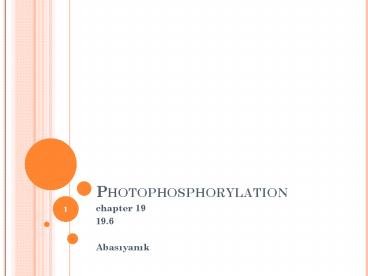Photophosphorylation - PowerPoint PPT Presentation
1 / 35
Title:
Photophosphorylation
Description:
PHOTOPHOSPHORYLAT ON * chapter 19 19.6 Abas yan k * * * * * * * * * * * * * * * * * * * * * * * * * * * * * * * * * * * * * PHOTOSYNTHES S: HARVEST NG L GHT ... – PowerPoint PPT presentation
Number of Views:478
Avg rating:3.0/5.0
Title: Photophosphorylation
1
Photophosphorylation
- chapter 19
- 19.6
- Abasiyanik
2
Photosynthesis harvesting light energy
- vascular plants and algae
3
- General Features
- H2O?electron donor (NADH in oxid.phosph)
- light ? good electron acceptor and donor
- similarity with OP electron carrying?proton
pumping?electrochemical potential ?ATP synthasis - in chloroplast
- Photosynthesis in 2 process in plants
- light depending reactions (light reactions)
plant illumated - Carbon-assimilation reactions (carbon fixation or
dark reactions) triose phosphates, starch,
sucrose and others produced (in chapter 20)
4
- Photosynthesis in CHLOROPLAST
- organelle found in plants and algea
- they have a third membrane system
- both light and dark reaction here
- a few micrometer in dia.
- two membranes?like mt
- inner membrane enclose thylakoids
- thylakoidsflattened vesicles (membrane)
- all pigments,
- electron-transport complexes
- ATP synthese
- grana thylakoid stack
- Adjacent grana are connected by non-stacked
membranes called stroma lamellae - The fluid around thylakoids ? stroma
- space inside thylakoids ? lumen.
5
light ? electron flow in chloplast
- Ochoa showed that NADPH is acceptor
6
light absorption
- visible light?400-700 nm (violent-red)
- photon? a quantum of light
- energy is higher at 400 than 700
- Why? frequency is higher at 400
7
- photon?hits to a chromophores electron
(absorbing molecules) ?higher energy level (all
or nothin event) ?excited state ?to ground state - as light, or heat or chemical work
excited state
- light (fluoresence?emit lower frequence)
- heat
- chemical work ?transfer of energy to
another?excition transfer
decay
ground state
8
Chlorophyll absorb light energy
- most import. pigment on thylakoid?chlorophyll
- chlorophyll?green pigment with polycyclic, planar
resembling protoporyphrin of hemoglobin with Mg2 - phytol side chain
- heterocyclic 5 ring aroung Mg?extended polyene
structure?absorption of light - two type a and b
- twice a than b in plants
- chlorophyles with LHC
- light-harveting complexes
- 7 a, 5 b, 2 accessory
- pigment (lutein)
9
bacteri ?phycobilins
- cynobacterai red algea?phycobilins
- phycoerythrobilin
- phycocyanoblin
- extended polyene system but no Mg
- covalently linked to protein phycobilinproteins
- associate in highly ordered complexes called
phycobilisomes - primary light-harvesting structure
10
Accessory Pigments in Plants
- second light absorbing pigments called accessory
pigments called carotenoids. - carotens yellow, red or pruple
- ?-carotene?most important one
- red-orange isoprenoid
- lutein (yellow carotenoids)
11
(No Transcript)
12
(No Transcript)
13
(No Transcript)
14
(No Transcript)
15
(No Transcript)
16
The Central Photochemical EventLight-Driven
Electron Flow
- 1952, Louis Duysen, Rhodospirillum rubrum, 870 nm
light?bleached - Kok and With?680-700 nm
- nonbioloigc electron acceptor (no
illumination)?bleaching - electron loss?bleaching
- pigments called ?P870, P680, P700
photosynthetic bacteria with simple
phototransduction machinery type 1 electron
?pheophytin (chlorophyll without Mg) ? a
quinone type 2 electron?a quinone ? an
iron-sulfur center Plants and cyanobacteria have
2 photosystems (PSI- PSII) in tandem
17
(No Transcript)
18
Type II reaction center Pheophytin-quinone
Reaction Center
exampleRhodobacter viridis?a large protein
complex wth 4 PPC 13 cofactors2 pairs
chlorophyll, a pair pheophytin, 2 quinones,
nonheme iron, 4 heme with c-type
cytocrome cyclic
like complex III in mt
19
Type I reaction center Fe-S Reaction center
like Type I Reaction center DIFFERENCE
like complex III in mt
20
(No Transcript)
21
In PlantsTwo Reaction system in Tandem
- In which organisms ?
- vascular plants
- Algea
- cyanobacteria
- Two different kinds of photosystems
- Photosytem II (PSII) pheophytin-quinone type of
system (like purple bacteria) with Chloropyll a
b - ab
- P680?e?cytochrome b6f ?proton movement
- Photosytem I (PSI) like green-sulfur bacteria
- agtb
- P700?e?Fe-S protein ferrodoxin?NADP ?NAPH
- plants PSI PSII works tandem to carry electron
form water to NADP - plastocyanin connects PSII to PSI
- protein
- like cytochrome c in mt
- oxygenic photosynthesis water ?NADPH and O2
22
Z scheme
23
(No Transcript)
24
(No Transcript)
25
(No Transcript)
26
(No Transcript)
27
(No Transcript)
28
(No Transcript)
29
(No Transcript)
30
(No Transcript)
31
(No Transcript)
32
(No Transcript)
33
(No Transcript)
34
(No Transcript)
35
(No Transcript)































